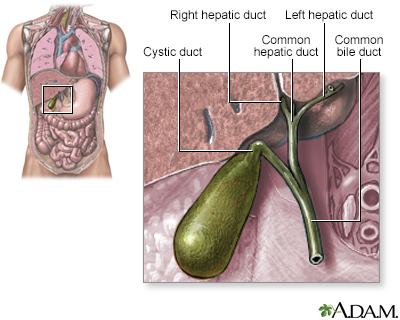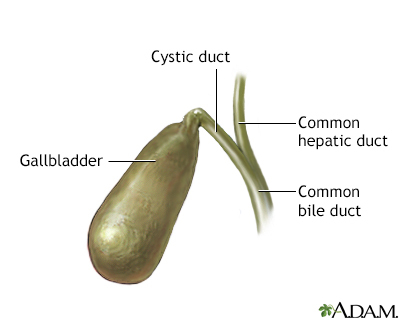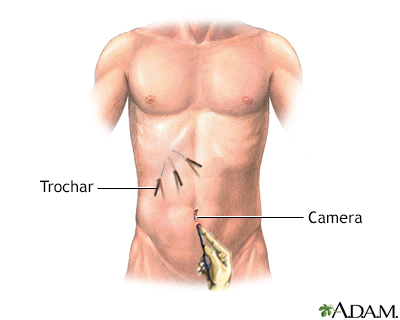Laparoscopic gallbladder removal
Definition
Laparoscopic gallbladder removal is surgery to remove the gallbladder using a medical device called a laparoscope.
The gallbladder is an organ that sits below the liver. It stores bile, which your body uses to digest fats in the small intestine.
Alternative Names
Cholecystectomy - laparoscopic; Gallbladder - laparoscopic surgery; Gallstones - laparoscopic surgery; Cholecystitis - laparoscopic surgery
Description
Surgery using a laparoscope is the most common way to remove the gallbladder. A laparoscope is a thin, lighted tube that lets the doctor see inside your belly.
Gallbladder removal surgery is done while you are under general anesthesia so you will be asleep and pain-free.
The operation is done the following way:
- The surgeon makes 3 to 4 small cuts in your belly.
- The laparoscope is inserted through one of the cuts.
- Other medical instruments are inserted through the other cuts.
- Gas is pumped into your belly to expand the space. This gives the surgeon more room to see and work.
The gallbladder is then removed using the laparoscope and other instruments.
An x-ray called a cholangiogram may be done during your surgery.
- To do this test, dye is injected into your common bile duct and an x-ray picture is taken. The dye helps find stones that may be outside your gallbladder.
- If other stones are found, the surgeon may remove them with a special instrument.
Sometimes the surgeon cannot safely take out the gallbladder using a laparoscope. In this case, the surgeon will use open surgery, in which a larger cut is made.
Why the Procedure Is Performed
You may need this surgery if you have pain or other symptoms from gallstones. You may also need it if your gallbladder is not working normally.
Common symptoms may include:
- Indigestion, including bloating, heartburn, and gas
- Pain after eating, usually in the upper right or upper middle area of your belly (epigastric pain)
- Nausea and vomiting
Most people have a quicker recovery and fewer problems with laparoscopic surgery than with open surgery.
Risks
Risks for anesthesia and surgery in general include:
- Reactions to medicines
- Breathing problems
- Bleeding, blood clots
- Infection
Risks for gallbladder surgery include:
- Damage to the blood vessels that go to the liver
- Injury to the common bile duct
- Injury to the small intestine or colon
- Pancreatitis (inflammation of the pancreas)
Before the Procedure
You may have the following tests done before your surgery:
- Blood tests (complete blood count, electrolytes, and kidney tests)
- Chest x-ray or electrocardiogram (ECG), for some people
- Several x-rays of the gallbladder
- Ultrasound of the gallbladder
Tell your health care provider:
- If you are or might be pregnant
- What medicines, vitamins, and other supplements you are taking, even ones you bought without a prescription
During the week before surgery:
- You may be asked to stop taking aspirin, ibuprofen (Advil, Motrin), vitamin E, warfarin (Coumadin), and any other drugs that put you at higher risk of bleeding during surgery.
- Ask your doctor which drugs you should still take on the day of your surgery.
- Prepare your home for any problems you might have getting around after the surgery.
- Your doctor or nurse will tell you when to arrive at the hospital.
On the day of surgery:
- Follow instructions about when to stop eating and drinking.
- Take the drugs your doctor told you to take with a small sip of water.
- Shower the night before or the morning of your surgery.
- Arrive at the hospital on time.
After the Procedure
If you do not have any problems, you will be able to go home when you are able to drink liquids easily and your pain can be treated with pain pills. Most people go home on the same day or the day after this surgery.
If there were problems during surgery, or if you have bleeding, a lot of pain, or a fever, you may need to stay in the hospital longer.
Outlook (Prognosis)
Most people recover quickly and have good results from this procedure.
Gallery



References
Radkani P, Hawksworth J, Fishbein T. Biliary system. In: Townsend CM Jr, Beauchamp RD, Evers BM, Mattox KL, eds. Sabiston Textbook of Surgery. 21st ed. St Louis, MO: Elsevier; 2022:chap 55.
Rocha FG, Clanton J. Technique of cholecystectomy: open and minimally invasive. In: Jarnagin WR, ed. Blumgart's Surgery of the Liver, Biliary Tract and Pancreas. 6th ed. Philadelphia, PA: Elsevier; 2017:chap 35.
